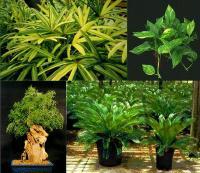Debate on green
2000/01/18 Roa Zubia, Guillermo - Elhuyar Zientzia
Scientists do not agree. According to some studies, domestic plants that are used to decorate enclosures significantly reduce air pollutants. The opposite is observed in other studies.

A concern of Western society is the environment generated in buildings. Among other things, in the offices the concentrations of benzene, formaldehyde and carbon monoxide are quite high. These molecules are volatile organic pollutants. Prolonged ingestion of all these substances through breathing causes workers to get tired, get angry easily and notice discomfort. It is known as disease syndrome in buildings. But, according to the knowledge of the street, the solution comes from the interior plants.
Scientific responsibility
To verify this claim, NASA and the Associated Landscape Contractors of America have conducted a two-year study. The research has used a dozen species that are usually found in the offices. After the introduction of plants in plastic containers, gases have been injected and a polluting atmosphere has been generated. The results have been very significant. All the plants analyzed are pollutants for their disposal. Some species eliminate formaldehyde more easily and others eliminate benzene, etc. The results are so successful that it has been decided to use them in future space stations.
But the latest New Sciencist magazine has not brought such good news: The final results are collected by researcher Peter Dingle, published in the specialized journal Bulletin of Enviromental Contamination and Toxicology. The research has developed around a single pollutant: formaldehyde. It is a substance that can irritate the eyes, throat, and skin. Formaldehyde may have its origin in pressed wood commonly used in buildings.
The research has used a higher level of pollutants in offices. He installed five floors every two days in eight-square-metre cabins. When there were more than ten plants in a cabin, there was no variation in formaldehyde concentration. Despite the pooling of twenty plants, there was no lower concentration than that of safety. However, more pollutants will have to be followed. On the other hand, the effect is mostly psychological and this should also be taken into account.
Few options for solid opinions
For street users, however, there are no reliable answers. Some yes, some no, we will have to wait long for scientists to accept. It may be a consequence of different research procedures. An agreement may never be reached. Scientists have no definitive methods for everything. As on other occasions, the quickest is the desire to know the street.

Gai honi buruzko eduki gehiago
Elhuyarrek garatutako teknologia



